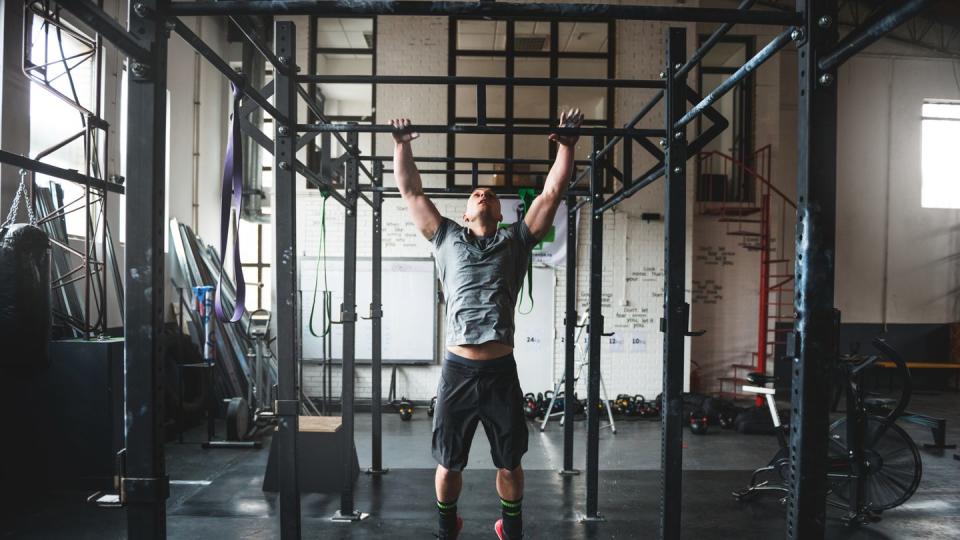The Muscles You're Actually Working When You Do a Pullup
PEOPLE OFTEN ASSOCIATE building strength with pumping iron, gauging progress by how many plates you can add to the bar, what size dumbbells you can lift, and how low you can set the pin in the machine stack. That’s one way to go about it, but it’s not the only way—and there’s one exercise that shines as an example of a move that breaks the iron rule: the pullup.
What makes the pullup such a powerful addition to any exercise arsenal is the type of strength it builds. Unlike the bench press, deadlift, squat, and other big compound lifts, the pullup doesn’t challenge your ability to heft an external load (a skill known as “absolute strength”). Instead, it requires you to raise your own bodyweight, testing and building what’s called “relative strength,” or how strong you are for your height and weight.
If you’ve ever performed a pullup, you know how challenging it is, and if you have any doubt about how effective lifting your own bodyweight can be for building strength and lean mass, consider gymnasts. Pound for pound, they’re among the strongest athletes in the world—and all they do is based around bodyweight training.
That’s not to say you should ditch dumbbells and plates to focus solely on bodyweight exercises, but weaving more moves like the pullup and pushup into your weekly routine can accelerate your gains—especially if you’re familiar with the muscles they target, the benefits they offer, and how to execute them with perfect form.
What Muscles the Pullup Works
Latissimus Dorsi
Brachialis
Biceps Brachii
Infraspinatus
Trapezius
Rhomboids
Teres Major
Subscapularis
Forearms
Core
Put simply, the pullup lights up nearly every muscle in your back, and it does so at least as effectively (and perhaps even more so) than any other exercise. What’s more, since the only way to raise your chest to the bar is to flex your elbows, every rep of the pullup is essentially a whole-body curl, making it an excellent biceps builder (especially when you flip the grip for a chinup). On top of all of that, you’ll feel the burn in your forearms, as your grip is the only thing keeping you latched onto the bar. To perform the pullup correctly and maximize force generation, you also need to keep your core tight, and that constant tension helps sculpt your abs into a head-turning washboard.
Honestly, it’s tough to imagine a more comprehensive upper body exercise than the pullup. But just as impressive and fascinating as the number of muscles it works is the order in which it emphasizes them.
According to a small 2020 study conducted by researchers from England’s Imperial College London, the traps, infraspinatus, and brachialis are engaged more acutely at the beginning of the pullup while the lats, teres major, and biceps are emphasized in the middle of the action. As your chest reaches the bar, your subscapularis kicks into high gear to finish off the movement. Even your triceps chip in at the end.
That same study also found that different pullup variations prioritize different muscles. The lats, traps, and rhomboids were more active in the wide-grip pullup while the biceps and brachialis exhibited higher engagement in the classic pullup. But no matter what variation you do, you’ll hammer your lats—hard—and enjoy muscle and strength building benefits that extend from your waist to your shoulders.
Benefits of the Pullup
Comprehensive upper body exercise
Requires minimal equipment
Builds relative strength
Let’s recap what we’ve learned so far. As explained above, few exercises equal the pullup in terms of the number of muscles it works. Plus, it’s one of the best moves you can do to target your lats, which are the fan shaped muscles on either side of your torso that give your upper body an enviable V-shape.
The pullup is also one of the most effective exercises for building relative strength, which is the most important type there is. Why? Because it’s what you’ll need to haul your ass out of a derailed train, up over the side of a cliff, or into rescue boat in an emergency. As if those weren’t reasons enough to build more relative strength, increasing it will benefit your absolute strength as well, helping to increase your performance in everything else you do.

There’s only one catch: The pullup is one of the most challenging exercises to master—a reason it commands so much respect among trainers. The average guy can only do two at a time, and you should be able to perform at least six in a row before you start doing sets.
How do you get there? To start, build up a base of strength performing related exercises as part of your workout routine. Once you're up on the bar, a good option is to use an assistive device, such as a resistance band, to help you build the strength necessary to bang out multiple unassisted reps. Another option is to perform one or two pullups between sets of other exercises. Do that consistently, and soon you’ll be able to increase that number to three, four, five, and then finally the six-rep threshold.
How to Do a Pullup
To set up for a pullup, make sure you have access to a stable bar that can bear your weight. From there:
Reach up and grasp the bar in an overhand grip. If you can't reach from the floor, use a box or bench to prop yourself up (try to avoid jumping if possible, especially when just starting out).
Make sure your palms are over the bar. Grip hard, squeezing the bar.
Squeeze your abs and glutes to create full-body tension. Depress your lats to create tension in your mid-back.
Pull your chest to the bar, moving only at the elbows.
Lower back down to the starting position.
You Might Also Like

